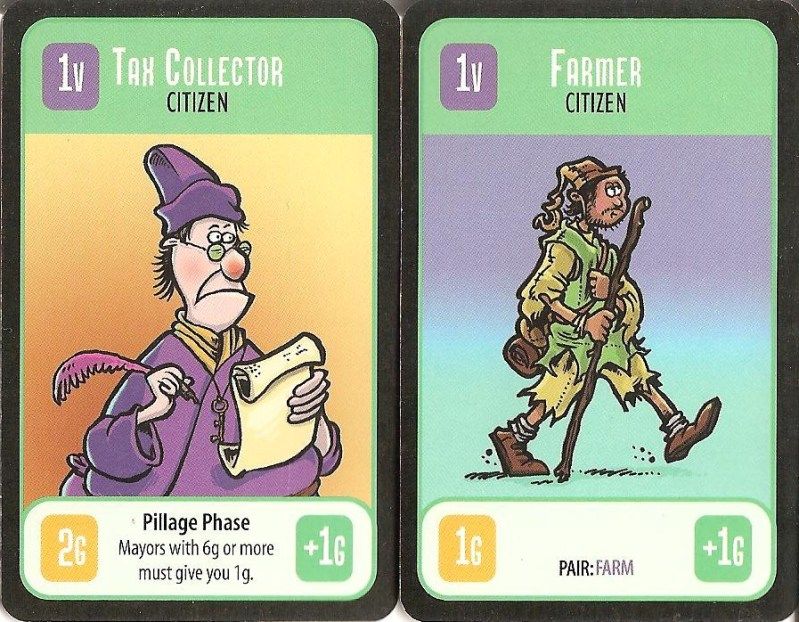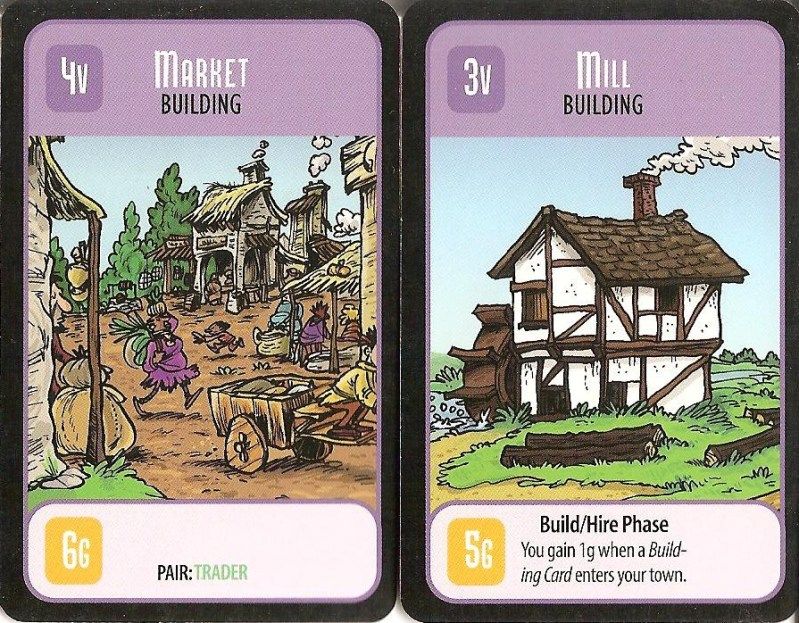Villagers & Villains (Studio 9/Aaron Kreader, 2011)
2-5 players / 9 + / 30-60 Minutes
Rollin', rollin', rollin'.
Rollin', rollin', rollin'.
Rollin', rollin', rollin'.
Rollin', rollin', rollin'.
Good cards!
Hah! Hah!
Keep rollin', rollin', rollin',
Though your village is gettin’ swollen,
Keep them dice a rollin', good cards!
Through citizens and buildings,
Heroes and villains,
Wishin' my luck wasn’t chillin’.
The good cards I'm missin',
The bad ones seem to be hissin',
“We’re waiting at the end of the line.”
Bring 'em out, lay 'em down,
Lay 'em down, bring 'em out.
Bring 'em out, lay 'em down:
Good cards!
Rollin', rollin', rollin'.
Rollin', rollin', rollin'.
Rollin', rollin', rollin'.
Good cards!
Hah! Hah!
Keep rollin', rollin', rollin',
Though your village is gettin’ swollen,
Keep them dice a rollin', good cards!
Through citizens and buildings,
Heroes and villains,
Wishin' my luck wasn’t chillin’.
The good cards I'm missin',
The bad ones seem to be hissin',
“We’re waiting at the end of the line.”
Bring 'em out, lay 'em down,
Lay 'em down, bring 'em out.
Bring 'em out, lay 'em down:
Good cards!
Cut 'em out, throw 'em in,
Throw 'em in, cut 'em out,
Cut 'em out, throw 'em in:
Good cards!
Hah! Hah!
What You Get:
Essentially, cards and tokens. The tokens are simple cardboard coins (64 total) in denominations of ‘1’ and ‘2.’ There is also a Start Player marker and a King’s Favor marker (used in the advanced game). The cards are sturdy for an independent press, though not as good of quality as you’d find with, say, Fantasy Flight or Rio Grande
The Quick Rundown:
In Villagers & Villains, you are neither a villager nor a villain, but trying to manage both. You are the mayor of a village trying to hire citizens and champions, erect buildings, and fight off challenges – all represented by cards in your tableau. The game ends after the round in which one or more players have played eight cards to their tableau, and then everyone counts up their points. The winning mayor gets a fancy sash. Game play is divided into five phases which is easier to discuss in dreaded “bullet-point” fashion. Trust me, I’m just as consternated about this as you are.
- Recruit Six cards are laid out in a row, numbered 1-6. Unclaimed Citizens, Champions, and Buildings from the previous turn are discarded while remaining Challenge cards are moved down to the lowest slots. Replenish to six cards, as needed. In turn order, you will announce which card you wish to recruit and then must roll that number (or higher) on the d6. If your roll succeeds, you may add the targeted card to your hand. Otherwise, you are stuck with whichever card is in the first slot, so aim low when you can.
- Defend If you get stuck with, or voluntarily take, a Challenge card in the Recruit phase, you now have to roll to defeat it. You always have a base town defense, but Champions give you better defense rolls and more of them. Victory means gold now, and possibly points later, while...
- Pillage Defeat means the opposite. Here you may lose gold if you cannot get rid of Challenges. If they hang around until the end of the game, you'll lose points, too.
- Earning Receive the amount of gold as indicated by Citizens in your city (not your hand).
- Build/Hire From your hand, you may hire one Citizen or Champion or build one structure per turn, paying the required gold as indicated on its card and playing it in your tableau. Citizens give you income each turn and maybe a special ability. Champions help defend against Challenges. Buildings provide points and may offer a special ability, as well.
Besides the point values you can earn listed on the cards, you can score bonuses by pairing certain cards together, or having the most Champions, or defeating the most Challenges, etc. There is a handy-dandy score sheet, yahtzee-style, to help in bookkeeping, as the end-of-game tallying is actually the most complicated part of this title, believe it or not.
E for Everyone:
You’re certainly welcome to bring your finely honed strategic mindset into this game. Just don’t think too hard. And you can definitely plan to build your tableau in an efficient, machine-like, point-scoring manner. But don’t bet the house on it. This title is fun, as long as you don’t pretend its something grander than you want it to be.
By and large, luck and die rolls tend to be great equalizers in the hobby. Villagers & Villains has those in spades. This will turn-off serious gamers only interested in titles that give the old gray matter a workout. But for those looking to engage in some good, frothy fun – especially with the kids – this card game will scratch the itch. The rules are light, game play is straight-forward, game length should always be under an hour, and the randomness gives all ages a fair shake.
Let me re-summarize that unpredictable nature, as it is probably the make-or-break factor for most gamers. Random element #1 begins with the cards in the recruit phase. Other than left-over challenges from the previous round, you have no idea which cards will be available until they pop up that turn, which makes planning problematic. Random element #2 lies in turn order, which is connected heavily with the order of the cards in the recruitment pool. Sometimes going first is advantageous if there are good cards in the first half of the pool, thus easier to nab as fist come, first serve. On the other hand, if the better cards are in the 4-6 slots, then going last can be advantageous in making it easier to roll for those higher cards which slide down in slots as the cards below are taken. Random element #3 is then, of course, simply rolling for the card you want. On top of that, any non-challenge cards leftover are discarded, which often results in a wanted card removed for the rest of the game! Random element #4 constitutes defense against challenges as you must roll certain numbers to defeat them. And finally, there are even some chance rolls and card draws in the special abilities, which rounds out this discussion with random element #5.
So how are we able to overcome such chaos? Well first and foremost, we actually enjoy rolling dice. Many gamers do. In addition to its equalizing qualities, dice rolling provides a fair amount of tension and laughter in equal parts, which is sort of ironic and fascinating when you stop to think about it. That aside, there are a few ways to roll with the chaos. First, you can grab cards that help to minimize the luck. Some cards provide aid in recruitment and defense rolls. Others allow you to draw extra cards by paying gold or defeating challenges. You can also simply purchase more dice during recruitment. Second, the advanced game includes the King’s Favor token which is, ironically, randomly placed on a card in the recruitment pool and then awarded to the player who earns that card. The King’s Favor can aid in recruitment, defense, income, or turn order. Once used, it is returned to the recruitment pool for the next round. And finally, there are multiple paths to victory, just in case you find yourself forced down a particular road. You can stock up on gold-producing citizens to buy the high value buildings. You can go for a village full of champions to get the hero bonus. Or you can even willingly take on and defeat the most villains for the challenge bonus. And if you feel particularly lucky, punk, aim to play matchmaker and pair up certain cards in your town for extra points.
In the end, I give Villagers & Villains an 8 on the Geek scale (Very good game. I like to play. Probably I'll suggest it and will never turn down a game.). The randomness will sometimes ruffle your feathers, but just remember that you're not the only bird in the nest. Once you learn to take the chaos in stride, you'll find a light-hearted, adequately themed game that is enjoyable and accessible for a great range of ages.






No comments:
Post a Comment